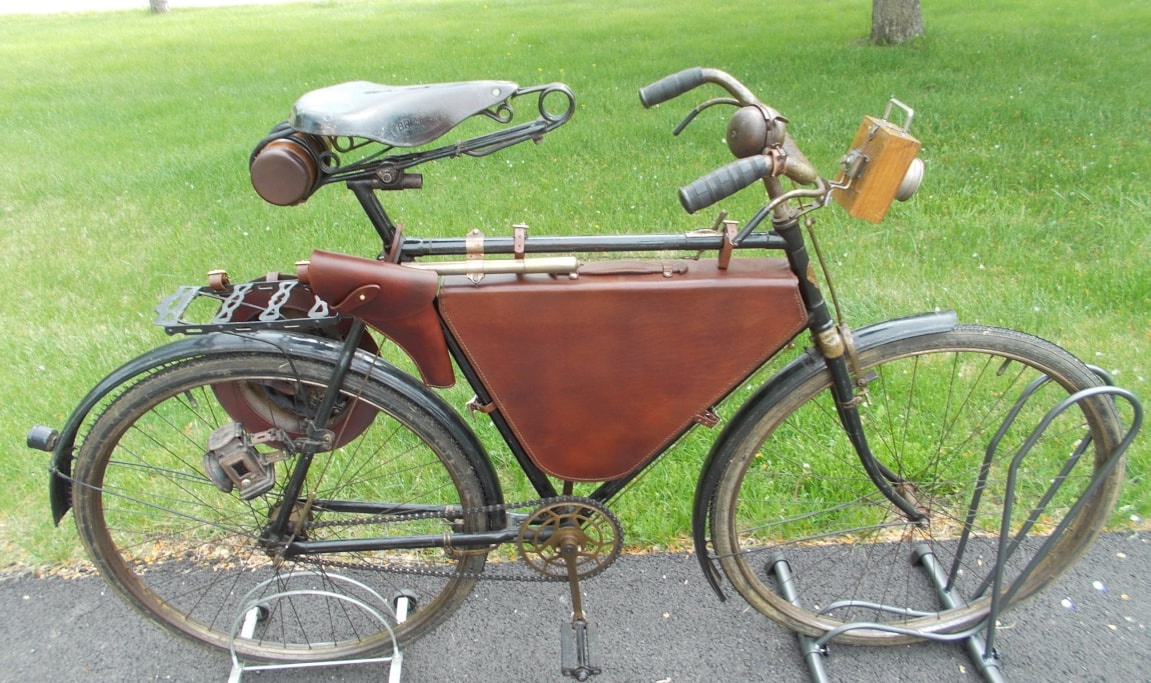This 1911 New Hudson Imperial bicycle was built in honor of the 100th anniversary of World War I. It appears as a new recruit might have outfitted it during the war, with a messenger bag, Brodie helmet, and Webley pistol (which the soldier would have worn on his belt during action). The wooden battery-operated lamp is dated 1915.
Colin Kirsch informs us that "During WW 1, all the major combatants deployed bicycles. It's not possible to know exactly how many military cyclists there were, but it's estimated that at least 100,000 British soldiers used bicycles in some capacity and at least 150,000 French and Belgians. A bicycle was an ideal means of transportation as it was comparatively lightweight–it could be carried over obstructions–and as well as being ridden could be loaded with equipment and pushed. It was particularly well-suited for conveying despatches, guerrilla action, patrols and reconnaissance–a motorcycle was faster, but the bicycle was silent." (Italics mine).
In 1914, the British army had 14,000 men in cycle regiments and battalions, increasing to 20,000 by the end of the war. When the Americans entered the war in 1917, they shipped 26,407 bicycles with them to France. They did not have any established bicycle corps, the bikes–and also Harley-Davidson motorcycles–being available as required.
"...The majority of bicycles used during WW 1 were normal roadsters. Military accessories were available from Terry, Brooks, Gamages or individual manufacturers. A rear carrier was the most common accessory. Front carriers and rifle clips were often fitted too. The most essential items were an inflator pump and a tool bag containing basic tools and puncture repair outfit." –The BSA and Military Bicycle Museum
This 1917 New Hudson is appropriately accessorized with a heavy-duty Brooks hairpin saddle and tool case, inflator pump, battery-operated wood lamp, bell, and kerosene rear lamp with ruby glass lens. The messenger bag, Brodie helmet case for belt or bicycle carrier, and Webley pistol and holster were accessories that might have been chosen by the individual soldier.
Colin Kirsch informs us that "During WW 1, all the major combatants deployed bicycles. It's not possible to know exactly how many military cyclists there were, but it's estimated that at least 100,000 British soldiers used bicycles in some capacity and at least 150,000 French and Belgians. A bicycle was an ideal means of transportation as it was comparatively lightweight–it could be carried over obstructions–and as well as being ridden could be loaded with equipment and pushed. It was particularly well-suited for conveying despatches, guerrilla action, patrols and reconnaissance–a motorcycle was faster, but the bicycle was silent." (Italics mine).
In 1914, the British army had 14,000 men in cycle regiments and battalions, increasing to 20,000 by the end of the war. When the Americans entered the war in 1917, they shipped 26,407 bicycles with them to France. They did not have any established bicycle corps, the bikes–and also Harley-Davidson motorcycles–being available as required.
"...The majority of bicycles used during WW 1 were normal roadsters. Military accessories were available from Terry, Brooks, Gamages or individual manufacturers. A rear carrier was the most common accessory. Front carriers and rifle clips were often fitted too. The most essential items were an inflator pump and a tool bag containing basic tools and puncture repair outfit." –The BSA and Military Bicycle Museum
This 1917 New Hudson is appropriately accessorized with a heavy-duty Brooks hairpin saddle and tool case, inflator pump, battery-operated wood lamp, bell, and kerosene rear lamp with ruby glass lens. The messenger bag, Brodie helmet case for belt or bicycle carrier, and Webley pistol and holster were accessories that might have been chosen by the individual soldier.
1911 Hudson Imperial bicycle ©Daniel Dahlquist





